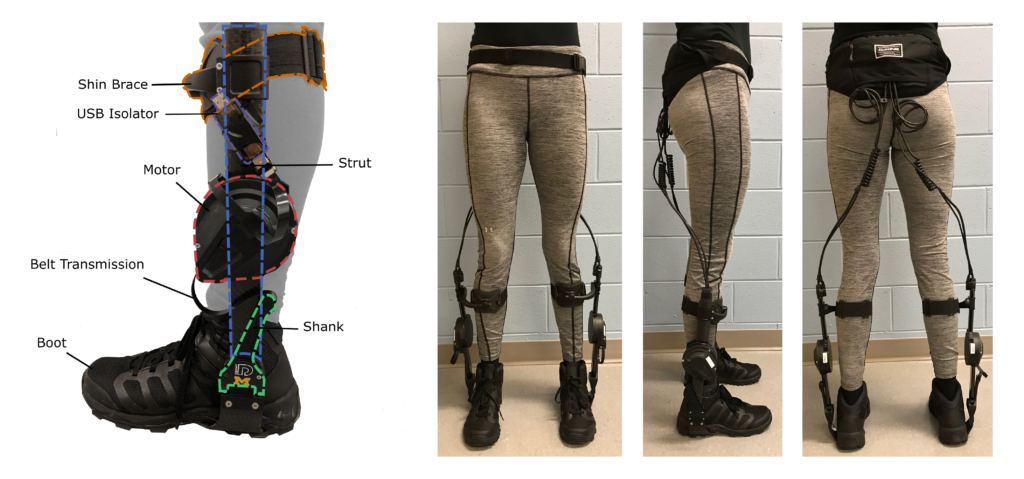Understanding Exoskeleton Use
Motivation
Robotic ankle exoskeletons can supplement the user’s biological ankle power with mechanical power from the device. These devices have the potential to restore healthy walking mechanics in individuals with mobility challenges or to augment the performance of able-bodied individuals by enabling them to walk farther, run faster or carry heavier loads. We are interested in how to best control these devices and seek to explore the complex physiological interactions between the exoskeleton and the human user.
Originally designed in the Biomechatronics Group at the MIT Media Lab, we use the Dephy ExoBoot exoskeletons, which are commercially available and manufactured by Dephy, Inc. (Maynard, MA). This system was the first autonomous (untethered) robotic ankle exoskeleton to reduce the energy cost of walking below that of walking without the exoskeleton.

The Dephy ExoBoot ankle exoskeleton used in the physical experiment. A brushless DC motor mounted on a rigid shank assists the user by generating torque through a belt drive transmission (slack in the image) that applies force on a boot-mounted strut. The exoskeleton is securely attached to the user via a shank attachment that transmits the actuator’s torque to the body.
Approach
With the development of lightweight, autonomous ankle exoskeletons (like the Dephy ExoBoot), we need to design controllers to assist the user. One commonly defined goal of ankle exoskeletons is to reduce the user’s metabolic cost—but this cost function doesn’t take into account more subjective measures such as pain, comfort, stability, or satisfaction. One way to tease out these subjective elements and how they relate to different control strategies is through user feedback about their preference. We let users self-tune their exoskeleton actuation profiles in 2 dimensions by controlling both the timing and magnitude of peak torque delivery using a touch screen tablet. We are interested in how reliably subjects can tune their own exoskeleton actuation settings in 2 dimensions and arrive at their preferred setting.
We are also investigating basic physiological questions, like evaluating how well users can sense differences in exoskeleton controllers and how well they can sense their own metabolic effort. To characterize this ability, we are calculating the Just Noticeable Difference (JND) of metabolic cost, which is the minimum perceivable change in metabolic cost that can be reliably detected. We use the ExoBoot to repeatedly impose different metabolic costs on test subjects over two-minute intervals. We then measure change in metabolic cost during each interval and ask subjects if they think the current cost is higher than previous one. We then aggregate these responses and obtain each subject’s JND.
Developing Metrics for Exoskeleton Evaluation
The minimum threshold of perceivable lower limb exoskeleton assistance is larger than the assistance provided by most state-of-the-art devices designed according to physiological metrics of success. This indicates that people are largely insensitive to metabolic benefits provided by these technologies, and the failure to perceive these benefits may impact adoption and use within society. This motivates the need for a metric that can capture exoskeleton performance along additional dimensions – ergonomics, comfort, and stability, to drive designs that users value in a holistic sense.
We have been validating an additional metric and associated approach to quantify exoskeleton success using the dollar ($) value of its assistance. The metric, termed Marginal Value (MV), involves participants completing a strenuous uphill walking task during which they are periodically asked to assign a dollar value to the effort of walking (price-to-walk), while engaging in a Seller’s Vickrey second-price auction. When engaging in this auction, participants compete against automated bidders (robo-bidders) modelled on human fatigue behavior instead of real competing participants. Over time, the reported dollar values (bids) create a specific fatigue profile which is used to determine the value of exoskeleton use. Our hope is that a metric aimed at capturing perceived value of exoskeletons can be used to develop more impactful designs in the future.
Contributors: Kim Ingraham, Leo Medrano, Nundini Rawal, Elliott Rouse
Publications
Medrano, R., Thomas, G. C., & Rouse, E. J. (2020). Methods for Measuring the Just Noticeable Difference for Variable Stimuli: Implications for Perception of Metabolic Rate with Exoskeleton Assistance. In International Conference on Biomedical Robotics and Biomechatronics. doi.org/10.1109/BioRob49111.2020.9224374
Mooney, L. M., Rouse, E. J., & Herr, H. M. (2014). Autonomous exoskeleton reduces metabolic cost of human walking. Journal of NeuroEngineering and Rehabilitation, 11(1), 151. doi.org/10.1186/1743-0003-11-151
Mooney, L. M., Rouse, E. J., & Herr, H. M. (2014). Autonomous exoskeleton reduces metabolic cost of human walking during load carriage. Journal of NeuroEngineering and Rehabilitation, 11(1), 80. doi.org/10.1186/1743-0003-11-80
